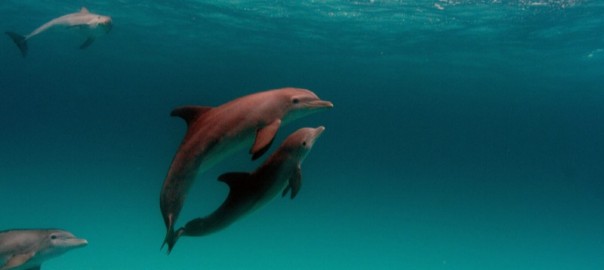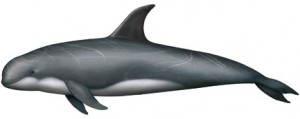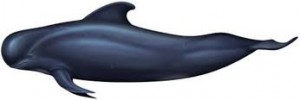As we said in our previous article, we can distinguish up to 30 different species of cetaceans in the waters surrounding the coast of our archipelago. The main classification we can make of these huge sea animals allows us to divide them in three big groups: whales and fin whales, beaked whales and dolphins and Risso’s dolphins.
Sometimes, as we have already said, these huge mammals approach us on our boat trips and turn our adventure into an unforgettable experience.
Whales and Fin whales
These cetaceans are the biggest ones you can watch in Fuerteventura, and coming across one of them is always an unforgettable experience. Whales and fin whales are represented, in the waters of the Biosphere Reserve in Fuerteventura, by many emblematic species such as the sperm whale, the fin whale and the bryde’s whale.
– Fin whale (Balaenoptera physalus)
The fin whale is the biggest cetacean we can watch in Fuerteventura. Only the blue whale is bigger, and it has been rarely seen in the Canary Islands (Tenerife and La Gomera). Sometimes it leaps up out of the water and it can reach a speed of 30km/h. It can have a length of up to 26mts although it’s something exceptional and the average is usually much shorter.
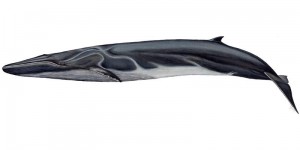
One of the ways to identify it is its asymmetrical pigmentation: on the right side we can see its white lower lip, and on the left side, it’s grey.
The Bryde’s whale is a solitary cetacean that can rarely be seen in big pods, although they usually gather in places where food is abundant (sardines, mackerel and krill).
Despite its size (baby whales can weight up to 900 kg at birth), it’s an agile animal and her way of swimming is more similar to a dolphin’s than to a whale’s, being able to leap up out of the water.
It’s very curious, approaches ships easily, swimming round or along with them.
In the Canary islands we can observe it from the end of the winter season until the summer.
– Sperm whale (Physeter macrocephalus)
It’s the only toothed whale among the big ones. It feeds on fish and big cephalopods, such as giant squids.
She can be under water for longer than two hours, diving up to 3km deep looking for food. They live in communities, either single male communities (made up of sexually inactive young male whales) or baby whales, usually from 20 to 25 specimens, although they can make bigger groups.

It’s the animal with the biggest brain in nature. It’s teeth are also the biggest in the animal kingdom, weighting up to 1k and being up to 20cms long each.
Adult males can be up to 20,5 mts long.
They usually rest by floating and drifting motionless. Its wide tale can be easily recognized when it lifts it in order to plunge.
Beaked whales
Beaked whales are the most unknown cetaceans of them all, even many of its species have never been seen alive. In many cases we only know about them thanks to studies made on dead specimens. Nowadays 20 species are known, although it’s believed that there might be some more to be found out.
In the Canary Island the most common species are the Blainville’s Beaked whale and the Cuvier’s Beaked whale.
– Blainville’s Beaked Whale (Mesoplodon densirostris)
The males have a couple of big teeth growing within raised bumps on their lower jaws, so they can easily be distinguished when observed. Although it isn’t easy to be seen, it’s one of the beaked whales which offer most possibilities. They dive for very short time, from 20 to 40 seconds, although it can dive up to 45 minutes when looking for food. The Blainville’s

Beaked Whale has the thickest bones in the whole animal kingdom. These characteristic teeth don’t grow on females, although they have similar bumps on the lower jaw, not as raised as in males.
– Cuvier’s Beaked Whale (Ziphius cavirostris)
It’s one of the most unknown members in the cetaceans’ family and although they can’t be seen easily, The Canary Islands is one of the best places to see them. They present a wide variety of colours. Adult whales are whitish (they can be mistaken for pilot whales) and their body is scored with scars. They have two little teeth at the tip of the lower jaw; its dorsal fin can be low and have a triangular shape, with an almost straight rear rim, although on some occasions whales with a more bended fin can be seen.
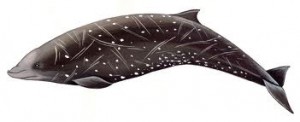
New born whales are among 2 and 3 mts long, while adult whales can even reach the 7mts. Their colour varies depending on sex and age.
Immersions can last from 20 to 40 minutes.
Dolphins and Risso’s dolphins
Delphinidae are the widest family of cetaceans and they include dolphins as well as risso’s dolphins, killer whales and porpoises.
The image of dolphins is widely known, their beak being their main characteristic although it isn’t a rating aspect. Risso’s dolphins have a rounded head, no beak, and the Canary Islands are one of the privileged places holding populations of this species in their waters.
– Common Dolphin (Delphinus delphis)
It can easily be recognised for their colours, with a dark “v” just below their dorsal fin, or for their pattern in the shape of an hourglass timer. They are usually found in very numerous groups, and their leaps can be seen and even heard in the distance. Their sharp squeaks can be heard outside the water, and their immersions can last around 8 minutes, although they usually dive from 10 seconds to 2 minutes.

It’s a very active dolphin, which likes acrobatic jumps out of the water, sometimes even somersaults.
It’s one of the most abundant cetaceans in the world, with a total population that is now estimated to comprise several million dolphins.
It’s the best known dolphin, usually seen in dolphinariums as part of water shows as well as in TV series and films. It has a very varied coloration, although light may make it look like an even grey.
When they feed, dolphins help one another, and they have even cooperated with local fishermen.

It’s a very strong dolphin that can be up to 3,9 mts long.
They usually jump in front of the ships and they are very curious and active.
It’s a very active dolphin and a wonderful jumper, sometimes jumping really high into the air, where it seems to remain suspended before splashing in the water. New born spotted dolphins have no spots: they appear as they grow up, becoming really big and numerous on big specimens.

They like following the whitewash trails of boats and they are very friendly, they even approach divers under the water.
It’s an exclusively Atlantic species, and it’s becoming more and more frequent in the Canary Islands.
It’s quite easy to identify because of its typical pattern on its sides. He plunges at least 200mts looking for food, from 5 to 10 minutes. They can make up really large communities, up to 500 of them, although in the Atlantic you find less than 100 dolphins together. They usually join the common dolphin, similar in size and shape although with different colour patterns.
It’s a great acrobat, it loves jumping and performing twists and cartwheels in the air. It can reach up to 7mts high when performing some of them. 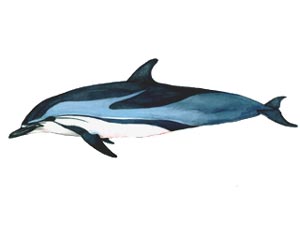
It’s dorsal fin is high in relation to its body size. Its colours may vary from blueish grey to brownish grey.
It’s very usual to see them following the whitewash trails of boats.
– Risso’s Dolphin (Grampus griseus)
They’re relatively easy to identify due to their body, scored with scars, which spread as they grow up. Their colour becomes lighter with age, although there are great variations, some adult specimens being as dark as other kind of pilot whales.
Their brow is slightly swollen, dying down considerably towards their mouth, where no beak can be made out.
It’s one of the species, together with the bottlenose dolphin, which most approaches the coast in the Canary Islands.
Its immersions are short, from 1 to 2 minutes, but they can remain under water up to 30 minutes.
– Short finned pilot whale (Globicephala macrorhynchus)
The short finned pilot whale is one of the cetaceans you can occasionally see in Fuerteventura, although in the Canary Islands there are resident populations all year round in Tenerife and La Gomera. Sometimes you can watch whole pods of whales floating idly. It’s usually black or dark grey, and its brow is rounded. It can plunge up to 40 minutes, reaching the 1000mts deep looking for squids and other cephalopods to feed.
On their head and rounded brow you find an organ known as “melon”, common to every toothed cetaceans. It’s thought to be useful for their echolocation. They make up pods from 10 to 30 specimens, and they have a matriarchal structure.
FuerteCharter’s Team
